
Best For
- Very low levels of motion transfer
- Extremely fast response, tied for fastest to date
- Excellent cooling with removable, washable cover
Considerations
- Low levels of bounce may not be great for sex
- Available in Canada only
Our Verdict
The Douglas Alpine mattress is an 11″ all-foam mattress with gel foam, traditional poly foam, and high-density support foam. This mattress had exceptional performance across the board and is under $1000 for a queen size.
The mattress comes in a single firmness option that is a 6 out of 10, where 10 is the most firm.
The Alpine has minimal sinkage (1.81″) and low levels of bounce (7.32″ total). This creates a mattress that is a little trickier to move around on, but shouldn’t create any sort of “stuck” sensation.
The Douglas Alpine has an overall score of 9.17, ranking it among the top 12% of all mattresses tested to date. For just foam mattresses, it is the top 3rd-best foam mattresses we’ve tested.
A queen-size Douglas Alpine is C$999, which is a savings of 45% or C$803 compared to the average Canadian mattress price. So no matter how you slice it, the Alpine is a fantastic value for its high performance and low cost.
Type: Foam
Firmness: Medium Firm (6)
Best For: All Sleeping Positions, All Body Weights
In This Review
Performance Tests | Firmness | Support & Sleeping Positions | Design | Materials | Comparisons | FAQs
Performance Tests
At NapLab, we put each mattress to the test.
We test 10 different factors that impact the performance, comfort, and value of the mattress. We then take the results of that test and compare to every mattress we’ve tested to date.
Check out the full performance table below to see how this mattress ranks:
| Factor | Douglas Alpine | Average |
|---|---|---|
| Overall Score | 9.17 | 8.55 |
| Price (Queen) | C$999 | $1,130 (Foam only) |
| Cooling – Score | 9.0 | 8.7 |
| Sinkage – Depth | 1.81″ | 2.15″ |
| Sinkage – Feel | Minimal | Moderate |
| Motion Transfer – Score | 9.6 | 8.2 |
| Motion Transfer – Acceleration | 5.89 m/s² | 8.79 m/s² |
| Response Time – Score | 10 | 8.9 |
| Response Time – Mostly Recovered | 0.2 sec. | 0.4 sec. |
| Response Time – Fully Recovered | 0.3 sec. | 0.9 sec. |
| Bounce – Height | 7.32″ | 9.51″ |
| Bounce – Feel | Low | Moderate |
| Edge Support – Score | 9.4 | 8.6 |
| Edge Support – Sitting | 3.25″ | 4.04″ |
| Edge Support – Lying | Excellent | Good |
| Sex – Score | 8.0 | 8.4 |
| Pressure Relief – Score | 9.0 | 8.7 |
| Comfort Layer Thickness | 4.5″ | 4.1″ |
| Mattress Thickness | 11″ | 12.0″ |
| Off-Gassing – Score | 8.6 | 8.2 |
| Off-Gassing – Smell | Strong | Strong |
| Off-Gassing – Days | 5 days | 6 days |
| Company – Score | 9.6 | 8.8 |
| Trial | 365 nights | 177 nights |
| Warranty | 20 years | 25% have lifetime warranties, average of other 75% of mattresses is 13 years |
How is the Alpine Different?
The Douglas Alpine is a high-quality Canadian mattress. According to NapLab data, the average price for a Canadian mattress is C$1,802 for a queen.
At C$999, the Douglas Alpine is a great budget option, saving you 45% compared to the average Canadian mattress.
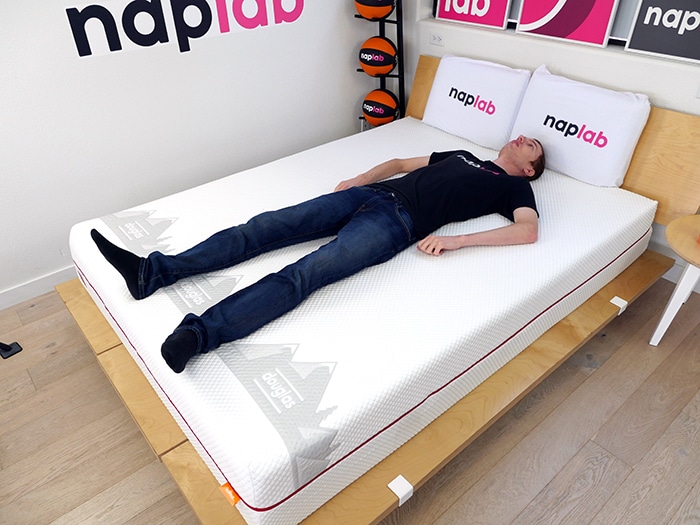
In addition to the savings, the Douglas Alpine is still a solid performer with a score of 9.17 overall. This score is above the average score of all foam mattresses we’ve tested (8.64).
This puts the Douglas Alpine in the top 15% of all foam mattresses we’ve tested to date.
As an added fun fact, the top three foam mattresses we’ve tested to date are all Douglas mattresses, with scores ranging from 9.02 – 9.35.
Advantages
The Douglas Alpine mattress has better-than-average performance in most areas. Categories like cooling and pressure relief are both excellent but also have a little room for improvement. However, response time, motion transfer, and edge support are all exceptional compared to most mattresses on the market.
Neutral Factors
As far as preferential factors like sinkage and bounce are concerned, the Alpine has minimal sinkage and low bounce. Sinkage is 16% less than the average mattress, while bounce is 23% lower than average.
Again, these are not good or bad things by themselves. You will have to figure out if they match with the type of mattress that fits your preferences.
Disadvantages
The biggest drawback for the Douglas Alpine is its sex performance. While it’s not bad by any means, the low bounce will translate to more work for amorous activities.
Cooling Test
Cooling performance on the Douglas Alpine was excellent. During our tests, I felt no significant level of heat retention around my body.
Baseline Temp.
69.8° F
Max Temp.
87.1° F
Ending Temp.
75.9° F
The Alpine mattress uses a phase change material (PCM) within the cover. These PCM fibers create a “cool to the touch” feel. Notably, it will heat up to body temperatures over time.
However, the cooler initial feel is great to help you get to sleep and also provides a cooling effect each time you change positions or move around on the mattress.
Max Temp.

Ending Temp

- Baseline Temperature – the temperature of the mattress before anyone lies on it
- Maximum Temperature (0 minute) – the temperature of the mattress after lying on it for 15 minutes
- Ending Temperature (5 minute) – the temperature of the mattress after being lied upon and having no one on it for 5 minutes
The all-foam design limits cooling performance to a degree. Ultimately, there’s just only so much an all-foam mattress can do. Even so, the Alpine does what it can, the foams seem to breathe well, and the cooling cover is a nice addition.
In our objective testing, we measured a maximum surface level temperature of 87.1°. From minutes 0 to 1 the temperature dropped by 5.7°, with minutes 0 to 5 dropping by 11.2°.
Heat Dissipation Over Time

Compared to the more expensive Douglas Summit mattress, the minute-by-minute heat dissipation was essentially the same. Overall, I’m pleased with the cooling performance.
Sinkage Test
The Douglas Alpine has a minimal level of sinkage. In our pressure point sinkage tests, we measured a sinkage depth of 1.81”. This is 0.34” less sinkage than the average of 2.15”.
Sinkage Depth
1.81″
Sinkage Feel
Minimal
Body Contour
Dramatic
The level of sinkage is documented in the image below.

While pressure point sinkage was a bit more restrained, the sinkage around my entire body felt far more moderate in its depth. Notably, my butt and mid-section sank a good bit more.
While the Alpine does not use any memory foam, the foam has many of the same qualities of memory foam. The mattress creates a sharp and exacting hug around the body, as it contours to each sleeper’s unique shape.
However, unlike memory foam, the feel is far cooler, not as dense / hard, and responds more quickly (which we’ll discuss more below).
Motion Transfer Test
The Douglas Alpine has a very low level of motion transfer. In our tests, we measured 5.89 m/s² of acceleration range. This is 33% less motion than the average of 8.79 m/s², based on all of our tests.
Accel. Range
5.89 m/s²
Motion Duration
0.46 seconds
The all-foam design, 11” total thickness, and medium-firm feel all work together to help keep motion quite restrained.
The level of motion transfer is documented in the video below.
Looking at our motion transfer chart, which visualizes our accelerometer data, we see the highest motion peak from 0 to 0.14 seconds.
Motion Transfer Over Time
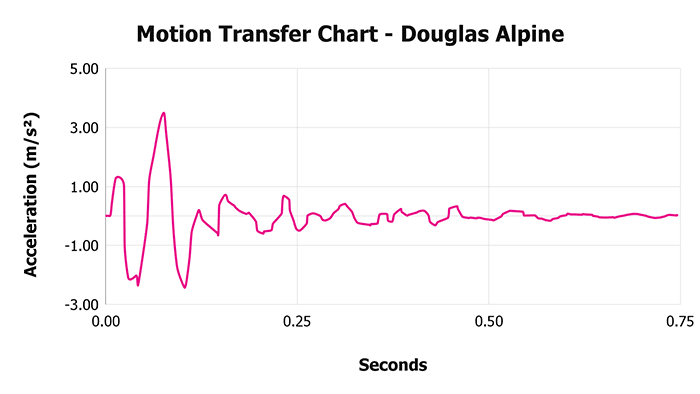
Motion drops dramatically thereafter and by 0.46 seconds it’s back to near zero. While the motion spikes aren’t the absolute lowest we’ve seen, the motion duration is quite low.
Overall, I’m impressed by the motion transfer on the Alpine. It does a great job at reducing motion-generating events quickly.
Response Test
The Douglas Alpine has an extremely fast material response. In our tests, we measured a mostly recovered response time of 0.2 seconds and a fully recovered response time of 0.3 seconds.
Mostly Recovered
0.2 sec.
Complete Recovery
0.3 sec.
This is tied with the fastest-responding mattresses we’ve tested to date. The Alpine manages to create the pressure-relieving comfort of memory foam, while also having a rapid response time.
The level of responsiveness is documented in the video below.
The mattress rebounds back to shape at the same speed as natural latex. The faster response helps ensure sleepers won’t feel stuck and makes it easier to move around on the mattress.
Bounce Test
The Douglas Alpine has a low level of bounce. In our tests, we measured 7.32” of total bounce height. This is 2.19” less bounce than the average of 9.51”.
Max. Depth
4.96″
Max. Rebound
2.36″
Total Bounce
7.32″
The lower level of bounce helps to keep motion transfer quite restrained. However, it also decreases the ease of movement and makes sex notably worse. The all-foam design of the mattress does the bounce no favors.
Max. Sinkage Depth

Max Bounce Height

The level of bounce is also documented in the video below.
While bounce is a preferential factor, you should carefully consider if the low bounce would work for you.
Some sleepers who have historically slept on coil mattresses have a hard time transitioning to all-foam mattresses, especially when the bounce is so low.
Edge Support Test
Edge support on the Douglas Alpine is excellent for both sitting and lying. In our sitting edge support tests, we measured 3.25” of sitting sinkage.
This is 0.79” less sinkage than the average of 4.04″, based on all of our tests to date.
In general, I like to see 4.00” of sitting sinkage compression or less. The Alpine hits and exceeds that mark.
Max. Sinkage
3.25″
Lying Support
Excellent
Reinforced Edge
No
As a result, I felt extremely well supported while sitting even directly on the edge of the mattress. Edge support while lying was equally as good.
The level of edge support while seated is documented in the images below.
Sitting, 140 lbs.

Sitting, 200 lbs.

The level of edge support while lying is documented in the images below.
Lying on Edge, 140 lbs.

Lying on Edge, 200 lbs.

During our tests, I felt well-supported while lying directly on the edge of the mattress. The foams are of high quality, have an appropriate firmness, and the 11” thickness all work together to create excellent edge support.
Sex Test
Our sex rating formula looks at 5 different factors weighted based on their importance.
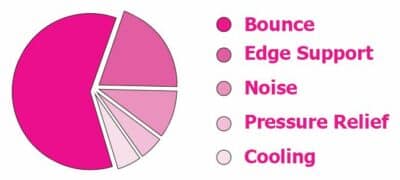
All factors are not equal in terms of significance, but each plays an important role.
Three of the most important factors are listed below with the associated testing scores:
Sex Bounce
9.3
Edge Support
9.9
Noise
10
In addition to the factors above, there are two other we consider as well, including pressure relief and cooling.
Here’s a look at the breakdown of how these 3 factors rank within the full formula:

We use the scores from all factors, plugged into the formula above, to derive a sex score for each mattress.
| Sex Factor | Factor Weight | Score | Rating |
|---|---|---|---|
| Bounce | 65% | 7.1 | Moderate |
| Edge Support | 20% | 9.7 | Excellent |
| Noise | 5% | 10 | Minimal |
| Pressure Relief | 5% | 9.0 | Excellent |
| Cooling | 5% | 9.0 | Excellent |
This mattress has a low bounce, which tends to hold the score down. When it comes to good sex performance, bounce is critically important to keep things active and engaging.
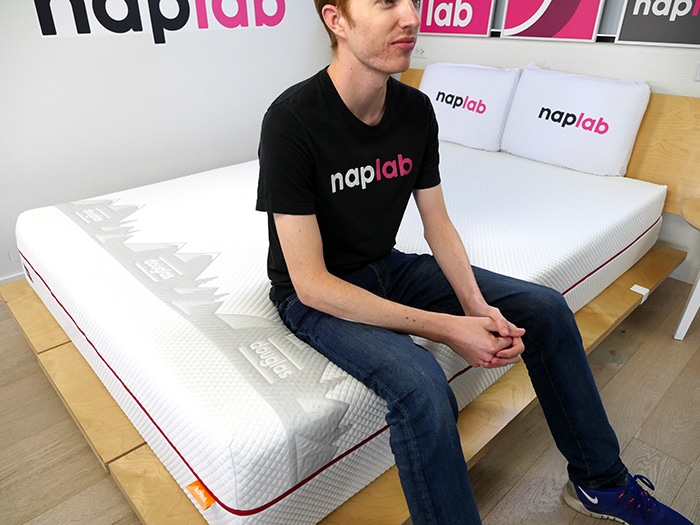
But bounce aside, the Alpine mattress has good edge support and is very comfortable overall.
Pressure Relief Test
The Douglas Alpine has excellent pressure relief. Throughout our tests and in all sleeping positions I felt no pressure point build up on my body.
Comfort Layer
4.5″
Support Layer
6.5″
The 4.5” comfort layer does a nice job at creating good pressure relief. Notably, the Alpine does not use memory foam. Instead, it uses gel foam and poly foam.
Despite this, the mattress feels like many other modern memory foam mattresses I’ve tested. It creates excellent pressure relief through an exacting contouring hug around the body.

Unlike memory foam, it has a rapid response on par with natural latex, does not significantly retain body heat, and is not heat reactive (ie, won’t get softer / firmer based on the temperature in the room / on the mattress).
Overall, I’m pleased with the pressure relief performance and I believe most sleepers will find pressure relief to be excellent.
Off-Gassing Test
Off-gassing on the Douglas Alpine was strong when we initially unboxes the mattress, but that’s not exactly uncommon.
Initial Smell Strength
Strong
Off-Gassing Period
5 days
The smell gradually dissipates over the course of a couple of days and by day 5, the odor was completely gone. On average, mattresses typically take 6.45 days to finish off-gassing.
To help a mattress off-gas faster, leave the mattress in a well-ventilated room and without any bedding or other sheets. Add a fan or air purifier to maximize airflow.
Company
The Douglas Alpine mattress is sold by GoodMorning.com, which also produces a number of other mattresses including Full Moon, Logan & Cove, and Novosbed.
| Company Factor | Factor Weight | Score | Data |
|---|---|---|---|
| Returns | 40% | 10 | $0 |
| Trial Period | 30% | 10 | 365 nights |
| Warranty | 20% | 8.0 | 20 years |
| Shipping | 10% | 10 | $0 |
| Country of Origin | 0% | Canada |
The mattress comes with a 365-night trial period and a 20-year warranty. Both shipping and returns are free (if the mattress ends up not working out).
How firm is the Douglas Alpine?
The Douglas Alpine mattress is a 6 out of 10 on the firmness scale. This is a medium firm feel and is suitable for a wide range of sleepers.

Support & Sleeping Positions
The Douglas Alpine has excellent support. In our tests, I felt fully supported in all sleeping positions. The mattress has a proven layered design and uses robust, high-quality foam materials.
| Support Factor | Data |
|---|---|
| Comfort Layer | 4.5″ |
| Support Layer | 6.5″ |
| Firmness | Medium-Firm |
| Body Contour | Dramatic |
| Zoned Support | No |
| Reinforced Edge | No |
The Alpine uses a 4.5” of comfort foam and 6.5” of support foam. With respect to comfort materials, I like to see a minimum of 3.0” and 4.0”+ whenever possible.

The mattress hits and exceeds that mark, which enables the right mix of comfort, pressure relief, and transitional support for sleepers.
While the 6.5” support foam could be slightly thicker, it’s still dense and thick enough to create good support. I expect most sleepers will find support to be perfectly acceptable.
Based on this subjective assessment, the Douglas Alpine would be supportive for all sleeper profiles noted below:
| Sleeper Weight | Stomach Sleepers | Side Sleepers | Back Sleepers |
|---|---|---|---|
| Under 150 lbs. | Yes | Yes | Yes |
| 150-250 lbs. | Yes | Yes | Yes |
| 250-300 lbs. | Yes | Yes | Yes |
Design
The Douglas Alpine mattress is an all-foam mattress with an 11″ profile and a medium firm feel (6 out of 10 on the firmness scale).
| Design Factor | Data |
|---|---|
| Type | Foam |
| Thickness | 11″ |
| Cover Type | Thin |
| Weight | 69 lbs. |
| Has Handles | No |
| Fiberglass-Free | Yes |
| Ships in a Box | Yes |

Materials
Within the 11″ profile, there are three primary layers on the Douglas Alpine mattress. From top to bottom, these layers include:
| Layer Type | Thickness | Layer Specs |
|---|---|---|
| Poly Foam | 2.25″ | Not Available |
| Poly Foam | 2.25″ | Not Available |
| Support Foam | 6.5″ | Not Available |

The top layer acts as a comfort layer, middle layer is a transitional layer, and the base layer is a support layer that helps
The Cover
The cover of the Douglas Alpine mattress is made of the same fabric as the original Douglas and Douglas Summit. It’s a lightweight, moisture-wicking, stretchy cover designed for breathability and easy maintenance. The cover easily zips right off the top of the mattress and is machine washable.

The Comfort Layer
The top comfort layer is 2.25″ gel foam which provides good compression and contour, without retaining heat.

Directly below the gel foam is a transitional poly foam called Elastex. This foam has a firmer feel than the comfort gel foam and improves response time as well.
The Support Layer
The bottom layer of the Douglas Alpine mattress is a high-density support foam. This foam is designed to support the layers above and help provide deep pressure relief.

Product Evolution
The Douglas Alpine launched at the end of 2022, the same time as the Douglas Summit mattress hit the market. Since its launch, it has undergone no notable design changes.
Other Mattresses to Consider
Not sure if the Alpine is the right pick for you? Check out these three other top-rated Canadian mattresses for alternative options.
For Pressure Relief
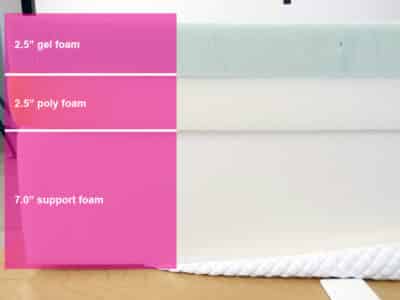
Douglas Summit
Best Performancec Score
The Douglas Summit mattress has a thicker comfort layer of 0.25″, which is a contributing factor to the higher overall score (9.84). This mattress is 12″ thick in totality.
For US Option
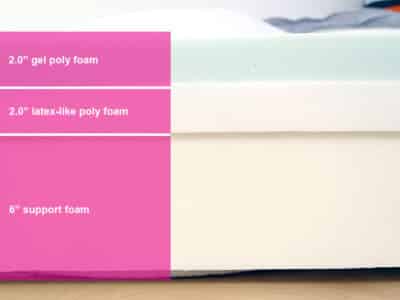
Douglas Original
Best Budget Model
The original Douglas mattress is available in the US or Canadian market. It had similar scores across the board and an overall score of that’s slightly lower than the rest. The Original has less bounce than the Alpine and is also slightly less expensive.
For Alternate Firmness
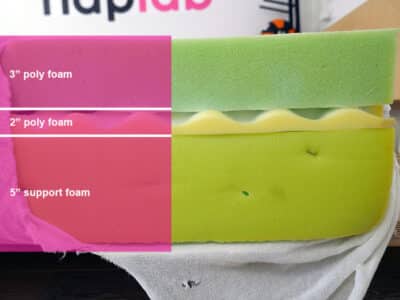
Nest Bedding Quail
Similar Performance
The Nest Bedding Quail mattress is a 10″ thick foam mattress with a combination of comfort poly foam, convoluted poly foam, and support foam. This mattress is available in a medium firmness (5 out of 10) or a lux firm (8 out of 10).
Frequently Asked Questions
Still have questions? Check out some of the top FAQs on the Douglas Alpine mattress below and get the answers you’re looking for.
Here are the current prices, with any sales or promotions reflected below:
Twin: C$799
Twin XL: C$849
Full: C$899
Queen: C$999
King: C$1099
Cal. King: C$1099
Split King: C$1678
*Note: Sales prices are subject to change without notice or warning.
No. Right now, the Douglas Alpine mattress is only available in the Canadian market. For a US-based Douglas mattress, check out the original Douglas.



